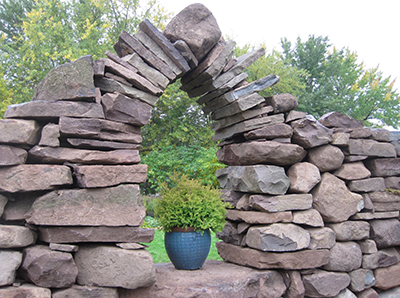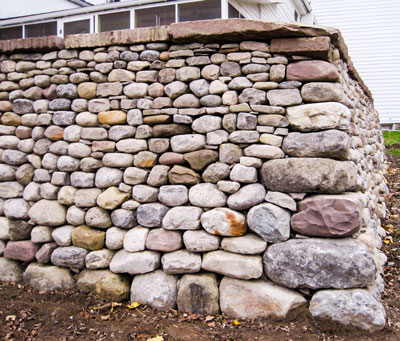 Stone walls add a strong and distinctive character to your property. A mentor once described stone walls as the "bones of a garden" - they create lines, form, and texture that inspires. Dry laid (mortarless) stone walls, arches, fire pits, patios, walkways, retaining walls, stairs, benches, pillars, pondless waterfalls, and decorative garden structures. Also repairing dry laid stone walls.
Stone walls add a strong and distinctive character to your property. A mentor once described stone walls as the "bones of a garden" - they create lines, form, and texture that inspires. Dry laid (mortarless) stone walls, arches, fire pits, patios, walkways, retaining walls, stairs, benches, pillars, pondless waterfalls, and decorative garden structures. Also repairing dry laid stone walls.
We are fortunate to live in an area with abundant glacial deposits of granite, sandstone and limestone. Local stone has an aesthetic sensibility that fits in beautifully in our area. It is the ultimate in “green”. It fits in harmony with our outdoor spaces.
Dry Laid Stone Walls
Dry laid stone work has strength and extreme longevity if constructed properly. The entire structure is placed in compression with gravity and friction binding it together. During freeze/thaw cycles that allow the ground to heave, a mortared structure can crack. Properly laid dry stone behaves like a woven basket and will tighten up internally while maintaining integrity.
Ancient civilizations built dry laid stone structures lasting for generations that still stand today. Witness the Greek Parthenon, the Egyptian Pyramids of Giza, and the Mayan temples of Mexico, to name just a few.
Dry laid stone needs no mortar. Mortar is a chemical based material that requires large amounts of energy to manufacture and transport. Does it make sense to pulverize stone into dust, then add chemicals, only to later reconstitute the mix with water back into stone (mortar) to "glue" rocks together?
Stone Wall Structure
 Good stone wall structure is hidden within and cannot be seen from the outside. Care must be taken to fill the internal voids with carefully chosen shim pieces called hearting. This, in effect, is the heart of a good wall. Hearting stones are typically made on site by breaking larger rocks into various size wedges. Poor quality stone walls can be identified when the waller simply pours gravel into the voids or shims the wall externally, rather than from within.
Good stone wall structure is hidden within and cannot be seen from the outside. Care must be taken to fill the internal voids with carefully chosen shim pieces called hearting. This, in effect, is the heart of a good wall. Hearting stones are typically made on site by breaking larger rocks into various size wedges. Poor quality stone walls can be identified when the waller simply pours gravel into the voids or shims the wall externally, rather than from within.
Good stone walls have very few vertical joints - always two stones over one, one stone over two. Frames are used to carefully lay out the batter. Batter is a term used to describe the angle of repose that keeps forces always pushing a wall to the internal, rather than wanting to fall outward.
Long stones are laid into the wall to knit the structure together. Sloppy wall builders tend to lay long stones lengthwise on the face where they will eventually work their way out and compromise the integrity of the wall, leading to failure.
Stone walls can be topped with various treatments. Vertical placed or flat cope stones are the most common. Living green tops are common in Europe and do very well in the North East United States. A variety of sedums, herbs, or turf grasses have a strikingly beautiful effect.


